Novel MLR-RF-Based Geospatial Techniques: A Comparison with OK
Abstract
1. Introduction
2. Literature Review
3. Materials and Methods
3.1. Multiple Linear Regression (MLR)
3.2. Random Forest Algorithm
- -row1: Best input attribute selected and its cutoff values in that subset
- -row2: Mean Squared Error for that subset
- -row3: Number of samples in that subset
- -row4: V (output e.g., chemical concentration) in that subset (the values are normalised between 0–1, which is not necessary for the decision tree).
3.3. Model Generalisation and Hyperparameter Tuning
3.4. Performance Evaluation
3.5. Bayesian Optimisation Algorithm (BOA)
- 1.
- Model (P(f|Dt−1)) the objective function (R-square value) using Equation (7).
- 2.
- Find best_mu; i.e., the mean of the best values from the model (P(f|Dt−1))
- 3.
- Find a new set of best candidate/s (hyperparameter values) through PI
- 4.
- Compute the actual objective function/s by the RF/MLR algorithm, i.e., R-square value based on 10-fold cross-validation.
- 5.
- Update data as , i.e., and associated objective function values … and go to step 1
- 6.
- If PI is insignificant or N iterations are reached, stop and report the best parameters.
3.6. SHapley Additive ExPlanations (SHAP)
3.7. The Walker Lake Dataset
4. Application of MLR and RF for Spatial Estimation
5. Results
6. Discussion
7. Conclusions
Author Contributions
Funding
Institutional Review Board Statement
Informed Consent Statement
Conflicts of Interest
References
- Rossi, M.E.; Deutsch, C.V. Mineral Resource Estimation; Springer: Dordrecht, The Netherlands, 2014; ISBN 9781402057175. [Google Scholar]
- Pyrcz, M.J.; Deutsch, C. Geostatistical Reservoir Modeling, 2nd ed.; Oxford University Press: New York, NY, USA, 2002; ISBN 0-19-513806-6. [Google Scholar]
- Monestiez, P.; Allard, D.; Froidevaux, R. geoENV III—Geostatistics for Environmental Applications. Proceedings of the Third European Conference on Geostatistics for Environmental Applications Held in Avignon, France, November 22–24; Springer: Dordrecht, The Netherlands, 2000; ISBN 978-0-7923-7107-6. [Google Scholar]
- Oliver, M.A. Geostatistical Applications for Precision Agriculture; Springer: New York, NY, USA, 2010; ISBN 978-90-481-9132-1. [Google Scholar]
- Azevedo, L.; Soares, A. Geostatistical Methods for Reservoir Geophysics; Springer: Cham, Switzerland, 2017; ISBN 978-3-319-53200-4. [Google Scholar]
- Leuangthong, O.; Khan, K.D.; Deutsch, C.V. Solved Problems in Geostatistics; Wiley: Hoboken, NJ, USA, 2008; ISBN 978-0-470-17792-1. [Google Scholar]
- Sarma, D. Geostatistics with Applications in Earth Sciences; Springer: Dordrecht, The Netherlands, 2006; ISBN 978-1-4020-9379-1. [Google Scholar]
- Pham, T.D. Grade estimation using fuzzy-set algorithms. Math. Geol. 1997, 29, 291–305. [Google Scholar] [CrossRef]
- Matheron, G. Principals of Geostatistics. Econ. Geol. 1962, 58, 1246–1266. [Google Scholar] [CrossRef]
- Kwon, H.; Yi, S.; Choi, S. Numerical investigation for erratic behavior of Kriging surrogate model. J. Mech. Sci. Technol. 2014, 28, 3697–3707. [Google Scholar] [CrossRef]
- Isaaks, E.H.; Srivastava, R.M. Applied Geostatistics, 1st ed.; Oxford University Press: New York, NY, USA, 1989; ISBN 978-0- 19-605013-4. [Google Scholar]
- Abedi, M.; Ali Torabi, S.; Norouzi, G.H.; Hamzeh, M.; Elyasi, G.R. PROMETHEE II: A knowledge-driven method for copper exploration. Comput. Geosci. 2012, 46, 255–263. [Google Scholar] [CrossRef]
- Dutaut, R.; Marcotte, D. A New Semi-greedy Approach to Enhance Drillhole Planning. Nat. Resour. Res. 2020, 29, 3599–3612. [Google Scholar] [CrossRef]
- Fatehi, M.; Asadi, H.H.; Hossein Morshedy, A. 3D Design of Optimum Complementary Boreholes by Integrated Analysis of Various Exploratory Data Using a Sequential-MADM Approach. Nat. Resour. Res. 2020, 29, 1041–1061. [Google Scholar] [CrossRef]
- Kumral, M.; Ozer, U. Computers & Geosciences Planning additional drilling campaign using two-space genetic algorithm: A game theoretical approach. Comput. Geosci. 2013, 52, 117–125. [Google Scholar] [CrossRef]
- Benndorf, J. Moving towards Real-Time Management of Mineral Reserves—A Geostatistical and Mine Optimization Closed-Loop Framework. In Mine Planning and Equipment Selection.; Drebenstedt, C., Singhal, R., Eds.; Springer International Publishing: Cham, Switzerland, 2014; pp. 989–999. ISBN 978-3-319-02678-7. [Google Scholar]
- Buxton, M.; Benndorf, J. The use of sensor derived data in optimisation along the Mine-Value-Chain. In Proceedings of the 15th International ISM Congress, Aachen, Germany, 16–20 September 2013; pp. 324–336. [Google Scholar]
- Muhammad, K.; Glass, H.J. Modelling Short-Scale Variability and Uncertainty During Mineral Resource Estimation Using a Novel Fuzzy Estimation Technique. Geostand. Geoanalytical Res. 2011, 35, 369–385. [Google Scholar] [CrossRef]
- Tutmez, B.; Tercan, A.E.; Kaymak, U.; Appelhans, T.; Mwangomo, E.; Hardy, D.R.; Hemp, A.; Nauss, T.; Tutmez, B.; Tercan, A.E.; et al. Fuzzy Modeling for Reserve Estimation Based on Spatial Variability. Math. Geol. 2007, 39, 87–111. [Google Scholar] [CrossRef]
- Appelhans, T.; Mwangomo, E.; Hardy, D.R.; Hemp, A.; Nauss, T. Evaluating machine learning approaches for the interpolation of monthly air temperature at Mt. Kilimanjaro, Tanzania. Spat. Stat. 2015, 14, 91–113. [Google Scholar] [CrossRef]
- Kapageridis, I.K.; Denby, B. Neural Network Modelling of Ore Grade Spatial Variability. In Perspectives in Neural Computing, Proceedings of the ICANN, Skovde, Sweden, 2–4 September 1998; Niklasson, L., Bodén, M., Ziemke, T., Eds.; Springer: London, UK, 1998; pp. 209–214. [Google Scholar]
- Dean, S. Journal of Natural Gas Science and Engineering Reservoir simulation and modeling based on artificial intelligence and data. J. Nat. Gas Sci. Eng. 2011, 3, 697–705. [Google Scholar] [CrossRef]
- Dou, J.; Yunus, A.P.; Tien Bui, D.; Merghadi, A.; Sahana, M.; Zhu, Z.; Chen, C.W.; Khosravi, K.; Yang, Y.; Pham, B.T. Assessment of advanced random forest and decision tree algorithms for modeling rainfall-induced landslide susceptibility in the Izu-Oshima Volcanic Island, Japan. Sci. Total Environ. 2019, 662, 332–346. [Google Scholar] [CrossRef]
- Dutta, S. Predictive Performance of Machine Learning Algorithms for Ore Reserve Estimation in Sparse and Imprecise Data. Ph.D. Thesis, University of Alaska Fairbanks, Fairbanks, AK, USA, 2006. [Google Scholar]
- Dutta, S.; Bandopadhyay, S.; Ganguli, R.; Misra, D. Machine Learning Algorithms and Their Application to Ore Reserve Estimation of Sparse and Imprecise Data. J. Intell. Learn. Syst. Appl. 2010, 2, 86–96. [Google Scholar] [CrossRef][Green Version]
- Gilardi, N.; Bengio, S. Comparison of four machine learning algorithms for spatial data analysis. In Mapping radioactivity in the environment—Spatial Interpolation Comparison 1997; Dubois, G., Malczewski, J., DeCort, M., Eds.; Office for Official Publications of the European Communities: Luxembourg, 2003; pp. 222–237. [Google Scholar]
- Gonçalves, Í.G.; Kumaira, S.; Guadagnin, F. Computers & Geosciences A machine learning approach to the potential- fi eld method for implicit modeling of geological structures. Comput. Geosci. 2017, 103, 173–182. [Google Scholar] [CrossRef]
- Gumus, K.; Sen, A. Comparison of spatial interpolation methods and multi-layer neural networks for different point distributions on a digital elevation model. Geod. Vestn. 2013, 57, 523–543. [Google Scholar] [CrossRef]
- Koike, K.; Matsuda, S.; Suzuki, T.; Ohmi, M. Neural Network-Based Estimation of Principal Metal Contents in the Hokuroku District, Northern Japan, for Exploring Kuroko-Type Deposits. Nat. Resour. Res. 2002, 11, 135–156. [Google Scholar] [CrossRef]
- Leone, S.; Rutile, S.; Limited, C.; Leone, S. Integrating artificial neural networks and geostatistics for optimum 3D geological block modelling in mineral reserve estimation—A case study. Int. J. Min. Sci. Technol. 2015, 26, 581–585. [Google Scholar]
- Li, J.; Heap, A.D.; Potter, A.; Daniell, J.J. Application of machine learning methods to spatial interpolation of environmental variables. Environ. Model. Softw. 2011, 26, 1647–1659. [Google Scholar] [CrossRef]
- Merwin, D.A.; Cromley, R.G.; Civco, D.L. Artificial neural networks as a method of spatial interpolation for digital elevation models. Cartogr. Geogr. Inf. Sci. 2002, 29, 99–110. [Google Scholar] [CrossRef]
- Rigol, J.P.; Jarvis, C.H.; Stuart, N. Artificial neural networks as a tool for spatial interpolation. Int. J. Geogr. Inf. Sci. 2001, 15, 323–343. [Google Scholar] [CrossRef]
- Yadav, A.; Satyannarayana, P. Multi-objective genetic algorithm optimisation of artificial neural network for estimating suspended sediment yield in Mahanadi River basin, India. Int. J. River Basin Manag. 2020, 18, 207–215. [Google Scholar] [CrossRef]
- Carranza, E.J.M.; Laborte, A.G. Random Forest Predictive Modeling of Mineral Prospectivity with Missing Values in Abra (Philippines). Comput. Geosci. 2015, 74, 60–70. [Google Scholar] [CrossRef]
- Veronesi, F.; Schillaci, C. Comparison between geostatistical and machine learning models as predictors of topsoil organic carbon with a focus on local uncertainty estimation. Ecol. Indic. 2019, 101, 1032–1044. [Google Scholar] [CrossRef]
- Hengl, T.; Nussbaum, M.; Wright, M.N.; Heuvelink, G.B.M.; Gräler, B. Random forest as a generic framework for predictive modeling of spatial and spatio-temporal variables. PeerJ 2018, 2018, e5518. [Google Scholar] [CrossRef]
- Baez-Villanueva, O.M.; Zambrano-Bigiarini, M.; Beck, H.E.; McNamara, I.; Ribbe, L.; Nauditt, A.; Birkel, C.; Verbist, K.; Giraldo-Osorio, J.D.; Xuan Thinh, N. RF-MEP: A novel Random Forest method for merging gridded precipitation products and ground-based measurements. Remote Sens. Environ. 2020, 239, 111606. [Google Scholar] [CrossRef]
- Fiorentini, N.; Maboudi, M.; Losa, M.; Gerke, M. Assessing resilience of infrastructures towards exogenous events by using ps-insar-based surface motion estimates and machine learning regression techniques. ISPRS Ann. Photogramm. Remote Sens. Spat. Inf. Sci. 2020, 5, 19–26. [Google Scholar] [CrossRef]
- Fiorentini, N.; Maboudi, M.; Leandri, P.; Losa, M.; Gerke, M. Surface motion prediction and mapping for road infrastructures management by PS-InSAR measurements and machine learning algorithms. Remote Sens. 2020, 12, 3976. [Google Scholar] [CrossRef]
- Xie, Z.; Chen, G.; Meng, X.; Zhang, Y.; Qiao, L.; Tan, L. A comparative study of landslide susceptibility mapping using weight of evidence, logistic regression and support vector machine and evaluated by SBAS-InSAR monitoring: Zhouqu to Wudu segment in Bailong River Basin, China. Environ. Earth Sci. 2017, 76, 313. [Google Scholar] [CrossRef]
- Lesniak, A.; Porzycka, S. Geostatistical computing in psinsar data analysis. In Computational Science—ICCS 2009; Allen, G., Nabrzyski, J., Seidel, E., van Albada, G.D., Dongarra, J., Sloot, P.M.A., Eds.; Lecture Notes in Computer Science; Springer: Berlin/Heidelberg, Germany, 2009; Volume 5544. [Google Scholar] [CrossRef]
- Liu, W.; Du, P.; Wang, D. Ensemble learning for spatial interpolation of soil potassium content based on environmental information. PLoS ONE 2015, 10, e0124383. [Google Scholar] [CrossRef]
- Liu, S.; Zhang, Y.; Ma, P.; Lu, B.; Su, H. A Novel Spatial Interpolation Method Based on the Integrated RBF Neural Network. Procedia Environ. Sci. 2011, 10, 568–575. [Google Scholar] [CrossRef]
- Kirkwood, C.; Cave, M.; Beamish, D.; Grebby, S.; Ferreira, A. A machine learning approach to geochemical mapping. J. Geochem. Explor. 2016, 167, 49–61. [Google Scholar] [CrossRef]
- Dai, F.; Zhou, Q.; Lv, Z.; Wang, X.; Liu, G. Spatial prediction of soil organic matter content integrating artificial neural network and ordinary kriging in Tibetan Plateau. Ecol. Indic. 2014, 45, 184–194. [Google Scholar] [CrossRef]
- Hastie, T.; Tibshirani, R.; Friedman, J. The Elements of Statistical Learning Data Mining, Inference, and Prediction, 2nd ed.; Series in Statistics; Springer: New York, NY, USA, 2009; ISBN 978-0-387-84857-0. [Google Scholar]
- Bishop, C.M. Pattern Recognition and Machine Learning; Springer: New York, NY, USA, 2006; Volume 2, ISBN 9780387310732. [Google Scholar]
- Russell, S.J.; Norvig, P. Artificial Intelligence A Modern Approach 4th Edition, 3rd ed.; Prentice Hall: Hoboken, NJ, USA, 2003; ISBN 9780136042594. [Google Scholar]
- Anees, M.T.; Abdullah, K.; Nawawi, M.N.M.; Ab Rahman, N.N.N.; Piah, A.R., Mt.; Syakir, M.I.; Ali Khan, M.M.; Abdul, A.K. Spatial estimation of average daily precipitation using multiple linear regression by using topographic and wind speed variables in tropical climate. J. Environ. Eng. Landsc. Manag. 2018, 26, 299–316. [Google Scholar] [CrossRef]
- Baltensperger, A.P.; Mullet, T.C.; Schmid, M.S.; Humphries, G.R.W.; Kövér, L.; Huettmann, F. Seasonal observations and machine-learning-based spatial model predictions for the common raven (Corvus corax) in the urban, sub-arctic environment of Fairbanks, Alaska. Polar Biol. 2013, 36, 1587–1599. [Google Scholar] [CrossRef]
- Bel, L.; Allard, D.; Laurent, J.M.; Cheddadi, R.; Bar-Hen, A. CART algorithm for spatial data: Application to environmental and ecological data. Comput. Stat. Data Anal. 2009, 53, 3082–3093. [Google Scholar] [CrossRef]
- Chatterjee, S.; Bandopadhyay, S.; Machuca, D. Ore grade prediction using a genetic algorithm and clustering Based ensemble neural network model. Math. Geosci. 2010, 42, 309–326. [Google Scholar] [CrossRef]
- Chatterjee, S.; Bhattacherjee, A.; Samanta, B. Ore grade estimation of a limestone deposit in India using an Artificial Nueral Network. Appl. GIS 2006, 2, 1–20. [Google Scholar] [CrossRef]
- Youkuo, C.; Yongguo, Y.; Wangwen, W. Coal seam thickness prediction based on least squares support vector machines and kriging method. Electron. J. Geotech. Eng. 2015, 20, 167–176. [Google Scholar]
- Badel, M.; Angorani, S.; Shariat Panahi, M. The application of median indicator kriging and neural network in modeling mixed population in an iron ore deposit. Comput. Geosci. 2011, 37, 530–540. [Google Scholar] [CrossRef]
- Kanevski, M.; Pozdnoukhov, A.; Timonin, V. Machine Learning for Spatial Environmental Variables; EPFL Press: Lausanne, Switzerland, 2018; ISBN 9781783980284. [Google Scholar]
- Rigol-Sanchez, J.P. Spatial interpolation of natural radiation levels with prior information using back-propagation artificial neural networks. Appl. GIS 2005, 1, 1–15. [Google Scholar] [CrossRef]
- Gupta, A.; Kamble, T.; Machiwal, D. Comparison of ordinary and Bayesian kriging techniques in depicting rainfall variability in arid and semi-arid regions of north-west India. Environ. Earth Sci. 2017, 76, 512. [Google Scholar] [CrossRef]
- Bargaoui, Z.K.; Chebbi, A. Comparison of two kriging interpolation methods applied to spatiotemporal rainfall. J. Hydrol. 2009, 365, 56–73. [Google Scholar] [CrossRef]
- Knudby, A.; LeDrew, E.; Brenning, A. Predictive mapping of reef fish species richness, diversity and biomass in Zanzibar using IKONOS imagery and machine-learning techniques. Remote Sens. Environ. 2010, 114, 1230–1241. [Google Scholar] [CrossRef]
- Benito, M.; Blazek, R.; Neteler, M.; Rut, S.; Ollero, H.S.; Furlanello, C. Predicting habitat suitability with machine learning models: The potential area of Pinus sylvestris L. in the Iberian Peninsula. Ecol. Modell. 2006, 7, 383–393. [Google Scholar] [CrossRef]
- Hong, H.; Pradhan, B.; Bui, D.T.; Xu, C.; Youssef, A.M.; Chen, W. Comparison of four kernel functions used in support vector machines for landslide susceptibility mapping: A case study at Suichuan area (China). Geomat. Nat. Hazards Risk 2017, 8, 544–569. [Google Scholar] [CrossRef]
- Arabameri, A.; Pradhan, B.; Rezaei, K. Gully erosion zonation mapping using integrated geographically weighted regression with certainty factor and random forest models in GIS. J. Environ. Manag. 2019, 232, 928–942. [Google Scholar] [CrossRef]
- Noori, A.M.; Pradhan, B.; Ajaj, Q.M. Dam site suitability assessment at the Greater Zab River in northern Iraq using remote sensing data and GIS. J. Hydrol. 2019, 574, 964–979. [Google Scholar] [CrossRef]
- Saba, K. Application of Machine Learning Algorithms in Hydrocarbon Exploration and Reservoir Characterization. Ph.D Thesis, The University of Arizona, Tucson, AZ, USA, 2018. [Google Scholar]
- Samanta, B.; Bandopadhyay, S.; Ganguli, R. Comparative evaluation of neural network learning algorithms for ore grade estimation. Math. Geol. 2006, 38, 175–197. [Google Scholar] [CrossRef]
- Samanta, B.; Bandopadhyay, S. Construction of a radial basis function network using an evolutionary algorithm for grade estimation in a placer gold deposit. Comput. Geosci. 2009, 35, 1592–1602. [Google Scholar] [CrossRef]
- Tutmez, B. An uncertainty oriented fuzzy methodology for grade estimation. Comput. Geosci. 2007, 33, 280–288. [Google Scholar] [CrossRef]
- Jafrasteh, B.; Fathianpour, N. A hybrid simultaneous perturbation artificial bee colony and back-propagation algorithm for training a local linear radial basis neural network on ore grade estimation. Neurocomputing 2017, 235, 217–227. [Google Scholar] [CrossRef]
- Goswami, A.; Mishra, M.K.; Patra, D. Investigation of general regression neural network architecture for grade estimation of an Indian iron ore deposit. Arab. J. Geosci. 2017, 10, 80. [Google Scholar] [CrossRef]
- Koike, K.; Matsuda, S.; Gu, B. Evaluation of Interpolation Accuracy of Neural Kriging with Application to Temperature-Distribution Analysis. Math. Geol. 2001, 33, 421–448. [Google Scholar] [CrossRef]
- Matías, J.M.; Vaamonde, A.; Taboada, J.; González-Manteiga, W. Comparison of Kriging and Neural Networks With Application to the Exploitation of a Slate Mine. Math. Geol. 2004, 36, 463–486. [Google Scholar] [CrossRef]
- Raghuvanshi, N. A Comprehensive List of Proven Techniques to Address Data Scarcity in Your AI Journey. Available online: https://towardsdatascience.com/a-comprehensive-list-of-proven-techniques-to-address-data-scarcity-in-your-ai-journey-1643ee380f21 (accessed on 12 May 2022).
- Chatterjee, S.; Bandopadhyay, S. Goodnews Bay Platinum Resource Estimation Using Least Squares Support Vector Regression with Selection of Input Space Dimension and Hyperparameters. Nat. Resour. Res. 2011, 20, 117–129. [Google Scholar] [CrossRef]
- Prasomphan, S.; Mase, S. Generating Prediction Map for Geostatistical Data Based on an Adaptive Neural Network Using only Nearest Neighbors. Int. J. Mach. Learn. Comput. 2013, 3, 98–102. [Google Scholar] [CrossRef]
- Sekulić, A.; Kilibarda, M.; Heuvelink, G.B.M.; Nikolić, M.; Bajat, B. Random forest spatial interpolation. Remote Sens. 2020, 12, 1687. [Google Scholar] [CrossRef]
- Zou, J.; Petrosian, O. Explainable AI: Using shapley value to explain complex anomaly detection ML-based systems. Front. Artif. Intell. Appl. 2020, 332, 152–164. [Google Scholar] [CrossRef]
- Rodríguez-Pérez, R.; Bajorath, J. Interpretation of machine learning models using shapley values: Application to compound potency and multi-target activity predictions. J. Comput. Aided. Mol. Des. 2020, 34, 1013–1026. [Google Scholar] [CrossRef]
- Cressie, N. Spatial prediction and ordinary kriging. Math. Geol. 1988, 20, 405–421. [Google Scholar] [CrossRef]
- Fox, E.W.; Ver Hoef, J.M.; Olsen, A.R. Comparing spatial regression to random forests for large environmental data sets. PLoS ONE 2020, 15, e0229509. [Google Scholar] [CrossRef]
- Hengl, T.; Heuvelink, G.B.M.; Stein, A. A generic framework for spatial prediction of soil variables based on regression-kriging. Geoderma 2004, 120, 75–93. [Google Scholar] [CrossRef]
- Journel, A.; Huijbregts, C. Mining Geostatistics; Academic Press: London, UK, 1978. [Google Scholar]
- Shi, Y.; Lau, A.K.; Ng, E.; Ho, H.; Bilal, M. A Multiscale Land Use Regression Approach for Estimating Intraurban Spatial Variability of PM 2.5 Concentration by Integrating Multisource Datasets. Int. J. Environ. Res. Public Health 2022, 19, 321. [Google Scholar] [CrossRef]
- Watson, M.W. Spatial Correlation Robust Inference in Linear Regression and Panel Models. Available online: https://www.princeton.edu/~umueller/SHAR.pdf (accessed on 20 January 2022).
- Hallin, M.; Lu, Z.; Tran, L.T. Local linear spatial regression. Ann. Stat. 2004, 32, 2469–2500. [Google Scholar] [CrossRef]
- Okunlola, O.A.; Alobid, M.; Olubusoye, O.E.; Ayinde, K.; Lukman, A.F.; Szűcs, I. Spatial regression and geostatistics discourse with empirical application to precipitation data in Nigeria. Sci. Rep. 2021, 11, 16848. [Google Scholar] [CrossRef]
- Grith, D.A. A linear regression solution to the spatial autocorrelation problem. J. Geogr. Syst. 2000, 2, 141–156. [Google Scholar] [CrossRef]
- Tahmasebi, P.; Hezarkhani, A. A hybrid neural networks-fuzzy logic-genetic algorithm for grade estimation. Comput. Geosci. 2012, 42, 18–27. [Google Scholar] [CrossRef]
- Ahn, S.; Ryu, D.; Lee, S. A Machine Learning-Based Approach for Spatial Estimation Using the Spatial Features of Coordinate Information. ISPRS Int. J. Geo-Inf. 2020, 9, 587. [Google Scholar] [CrossRef]
- Beale, C.M.; Lennon, J.J.; Yearsley, J.M.; Brewer, M.J.; Elston, D.A. Regression analysis of spatial data. Ecol. Lett. 2010, 13, 246–264. [Google Scholar] [CrossRef]
- Arbia, G. Spatial Linear Regression Models. In A Primer for Spatial Econometrics with Applications in R; Palgrave Macmillan: London, UK, 2014; pp. 51–98. ISBN 978-0-230-36038-9. [Google Scholar]
- Saputro, D.R.S.; Muhsinin, R.Y.; Widyaningsih, P.; Sulistyaningsih. Spatial autoregressive with a spatial autoregressive error term model and its parameter estimation with two-stage generalised spatial least square procedure. J. Phys. Conf. Ser. 2019, 1217, 012104. [Google Scholar] [CrossRef]
- Cheung, T.K.Y.; Cheung, K.C. Spatial dependence model with feature difference. J. Forecast. 2020, 39, 615–627. [Google Scholar] [CrossRef]
- Breiman, L. Random forests. Mach. Learn. 2001, 45, 5–32. [Google Scholar] [CrossRef]
- Hayes, T.; Usami, S.; Jacobucci, R.; McArdle, J.J. Using classification and regression trees (CART) and random forests to analyse attrition: Results from two simulations. Psychol. Aging 2015, 30, 911–929. [Google Scholar] [CrossRef]
- Shamrat, F.M.J.M.; Ranjan, R.; Hasib, K.M.; Yadav, A.; Siddique, A.H. Performance Evaluation Among ID3, C4.5, and CART Decision Tree Algorithm CART Decision Tree Algorithms. In Proceedings of the International Conference on Pervasive Computing and Social Networking [ICPCSN 2021], Salem, Tamil Nadu, India, 19–20 March 2021; p. 15. [Google Scholar]
- Yadav, S.; Shukla, S. Analysis of k-Fold Cross-Validation over Hold-Out Validation on Colossal Datasets for Quality Classification. In Proceedings of the 6th International Advanced Computing Conference, IACC 2016, Bhimavaram, India, 27–28 February 2016; pp. 78–83. [Google Scholar]
- Bui, D.T.; Shahabi, H.; Omidvar, E.; Shirzadi, A.; Geertsema, M.; Clague, J.J.; Khosravi, K.; Pradhan, B.; Pham, B.T.; Chapi, K.; et al. Shallow Landslide Prediction Using a Novel Hybrid Functional Machine Learning Algorithm. Remote Sens. 2019, 11, 931. [Google Scholar] [CrossRef]
- Pradhan, B. A comparative study on the predictive ability of the decision tree, support vector machine and neuro-fuzzy models in landslide susceptibility mapping using GIS. Comput. Geosci. 2013, 51, 350–365. [Google Scholar] [CrossRef]
- Khosravi, K.; Shahabi, H.; Pham, B.T.; Adamowski, J.; Shirzadi, A.; Pradhan, B.; Dou, J.; Ly, H.B.; Gróf, G.; Ho, H.L.; et al. A comparative assessment of flood susceptibility modeling using Multi-Criteria Decision-Making Analysis and Machine Learning Methods. J. Hydrol. 2019, 573, 311–323. [Google Scholar] [CrossRef]
- Marjanović, M.; Kovačević, M.; Bajat, B.; Voženílek, V. Landslide susceptibility assessment using SVM machine learning algorithm. Eng. Geol. 2011, 123, 225–234. [Google Scholar] [CrossRef]
- Tehrany, M.S.; Pradhan, B.; Jebur, M.N. Flood susceptibility mapping using a novel ensemble weights-of-evidence and support vector machine models in GIS. J. Hydrol. 2014, 512, 332–343. [Google Scholar] [CrossRef]
- Bajaj, A. Performance Metrics in Machine Learning [Complete Guide]. Available online: https://neptune.ai/blog/performance-metrics-in-machine-learning-complete-guide (accessed on 1 May 2022).
- Sinclair, A.J.; Blackwell, G.H. Applied Mineral Inventory Estimation, 1st ed.; Cambridge University Press: Cambridge, UK, 2002; ISBN 0511031459. [Google Scholar]
- Wu, J.; Chen, X.Y.; Zhang, H.; Xiong, L.D.; Lei, H.; Deng, S.H. Hyperparameter optimisation for machine learning models based on Bayesian optimisation. J. Electron. Sci. Technol. 2019, 17, 26–40. [Google Scholar] [CrossRef]
- Snoek, J.; Larochelle, H.; Adams, R.P. Practical Bayesian optimisation of machine learning algorithms. In Proceedings of the NIPS’12: Proceedings of the 25th International Conference on Neural Information Processing Systems, Lake Tahoe, NV, USA, 3–6 December 2012; pp. 2951–2959. [Google Scholar]
- Martin, P.; David, E.G.; Erick, C.-P. BOA: The Bayesian optimisation algorithm. In Proceedings of the 1st Annual Conference on Genetic and Evolutionary Computation—Volume 1, Orlando, FL, USA, 13–17 July 1999; Morgan Kaufmann Publishers Inc.: San Francisco, CA, USA, 1999; pp. 525–532. [Google Scholar]
- Khan, A.U.; Salman, S.; Muhammad, K.; Habib, M. Modelling Coal Dust Explosibility of Khyber Pakhtunkhwa Coal Using Random Forest Algorithm. Energies 2022, 15, 3169. [Google Scholar] [CrossRef]
- Shapely, L.S. A Value for n-Person Games. In Contributions to the Theory of Games (AM-28), Volume II. In Annals of Mathematics Studies; Kuhn, H.W.A., Tucker, A.W., Eds.; Princeton University Press: Princeton, NJ, USA, 1953; pp. 307–317. [Google Scholar]
- Py Find, install and publish Python packages with the Python Package Index. Available online: https://pypi.org/ (accessed on 22 December 2021).
- Oshiro, T.M.; Perez, P.S.; Baranauskas, J.A. How Many Trees in a Random Forest? BT—Machine Learning and Data Mining in Pattern Recognition. In Lecture Notes in Computer Science, Proceedings of the Machine Learning and Data Mining in Pattern Recognition, MLDM 2012; Perner, P., Ed.; Springer: Berlin/Heidelberg, Germany, 2012; Volume 7376, pp. 154–168. [Google Scholar]
- Mery, N.; Marcotte, D. Quantifying Mineral Resources and Their Uncertainty Using Two Existing Machine Learning Methods. Math. Geosci. 2022, 54, 363–387. [Google Scholar] [CrossRef]

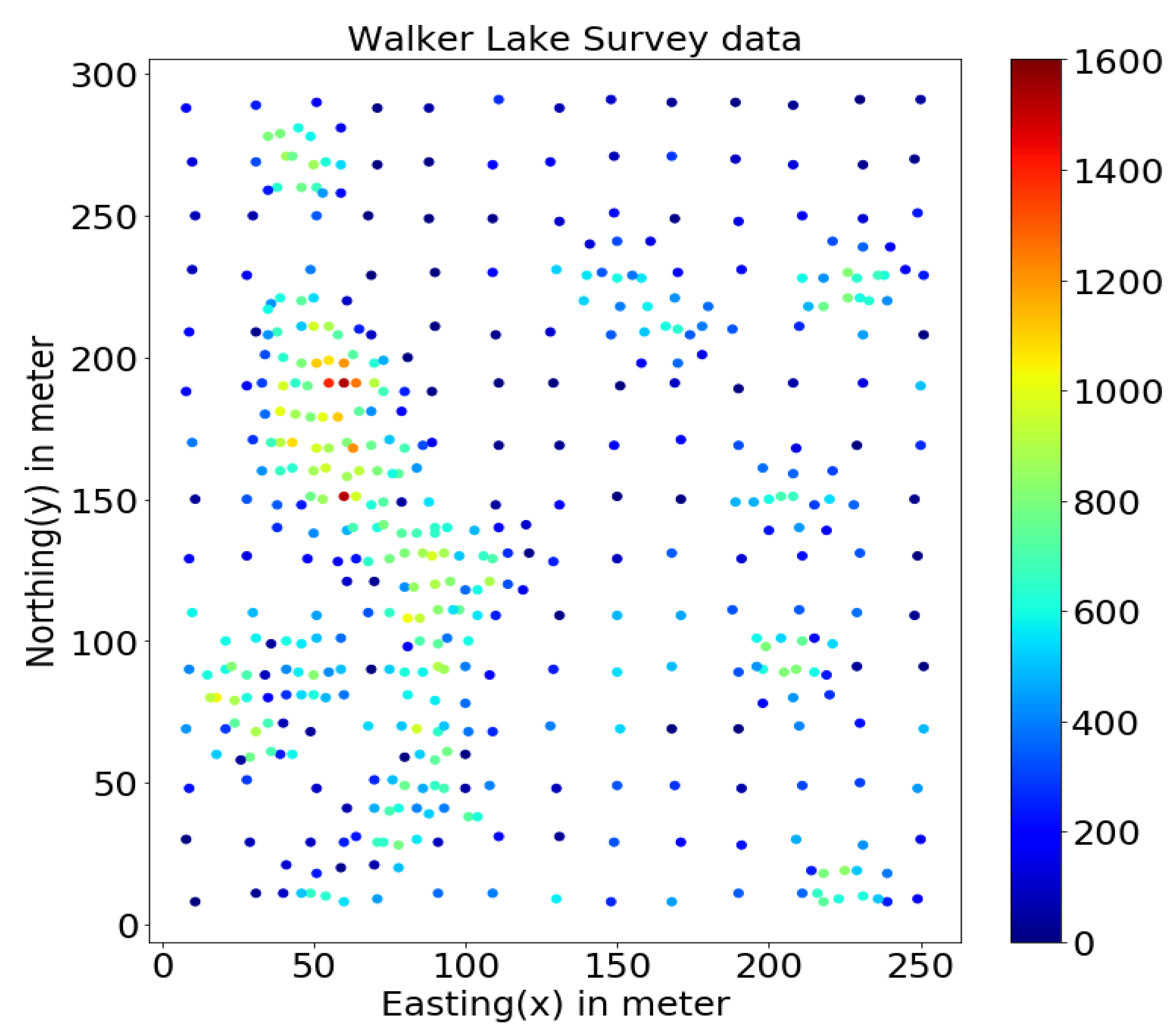
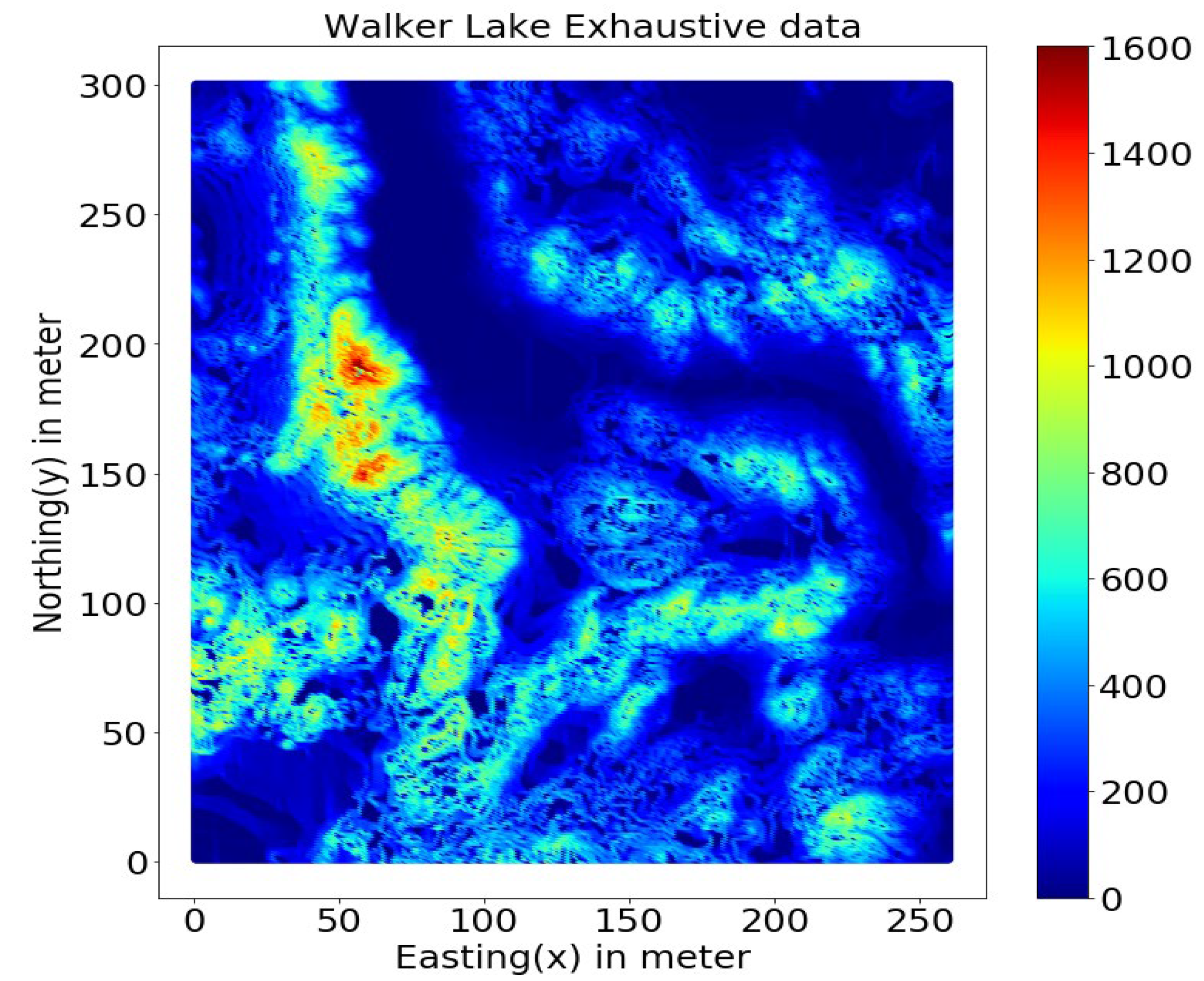


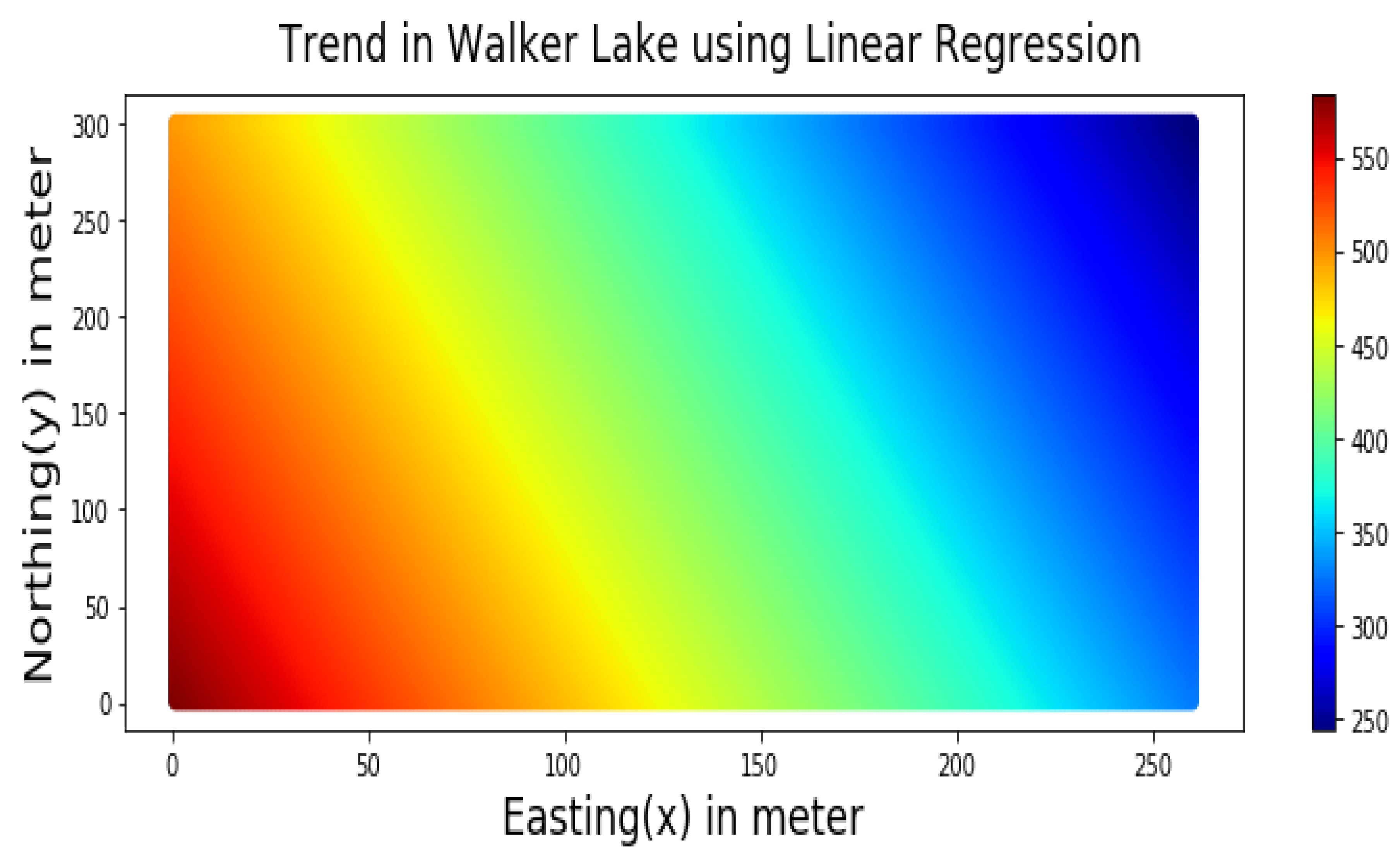
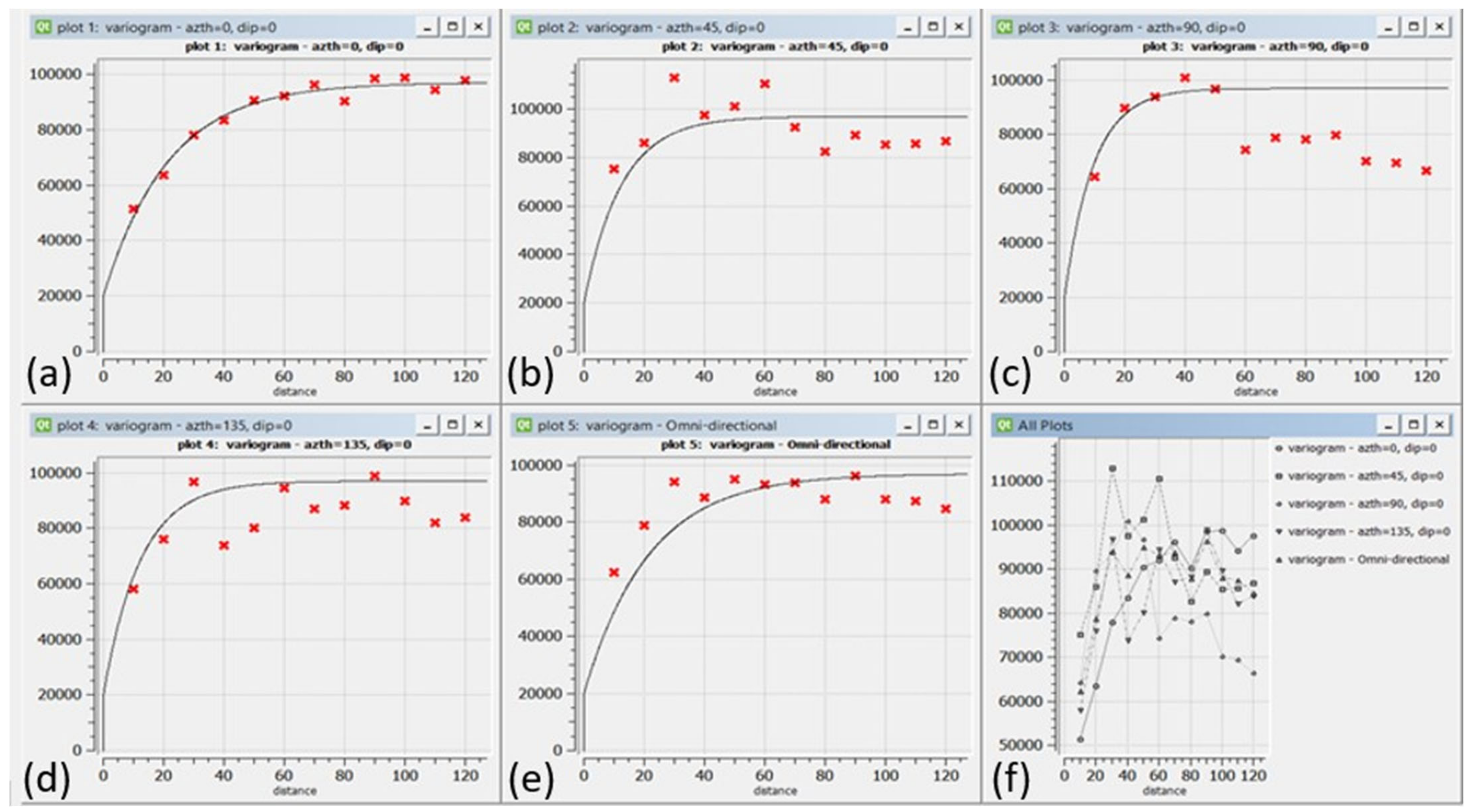

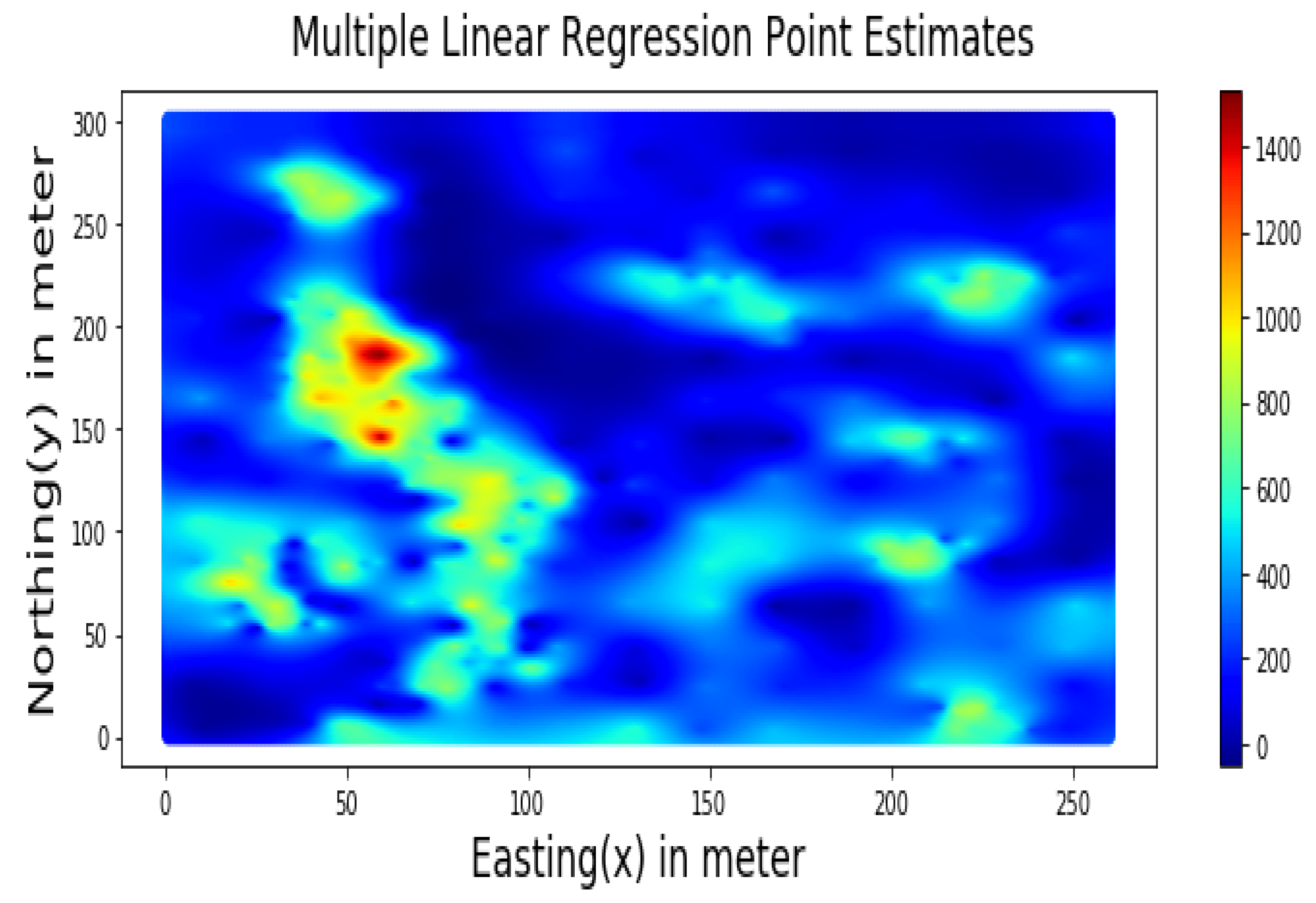
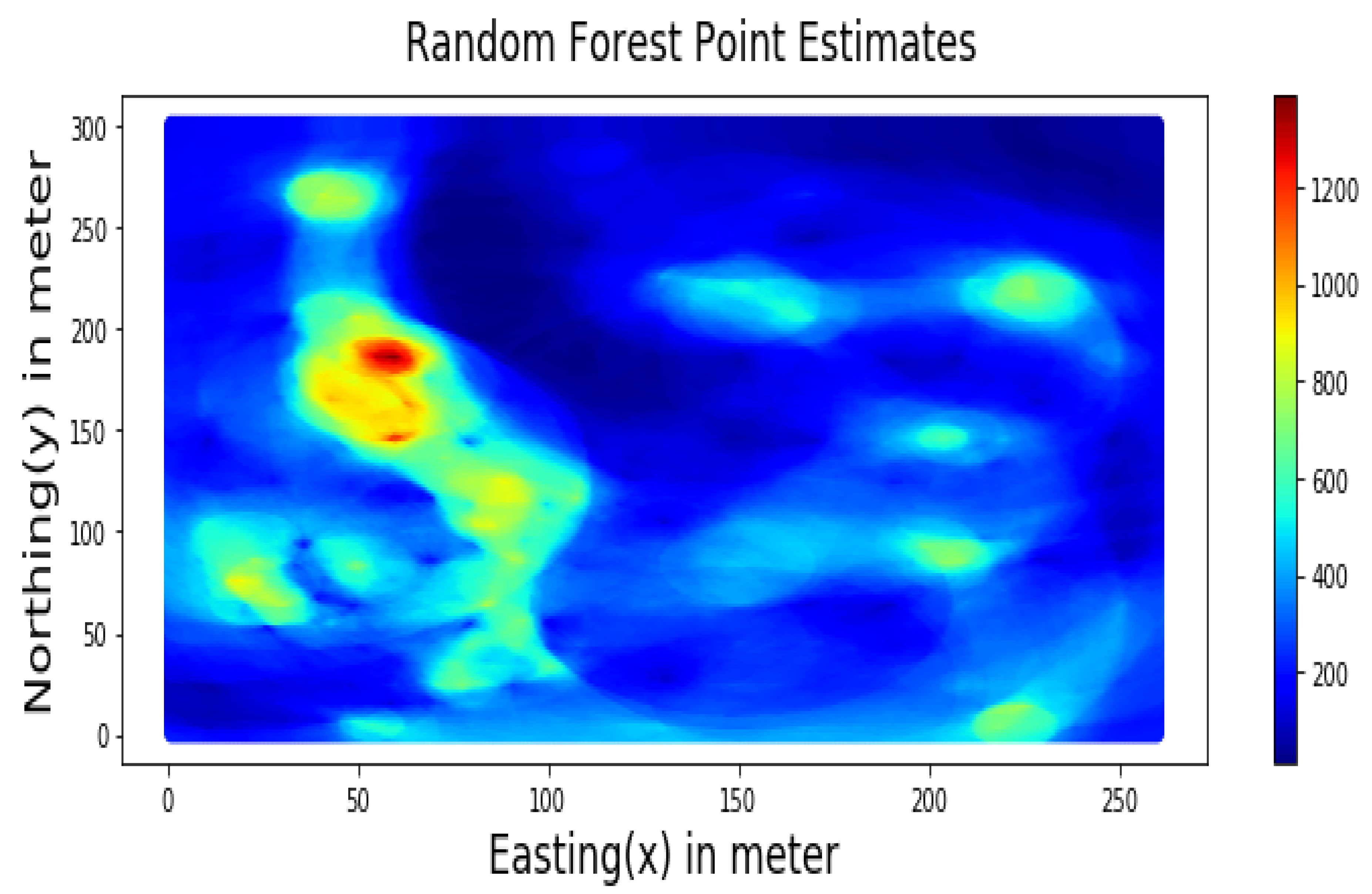
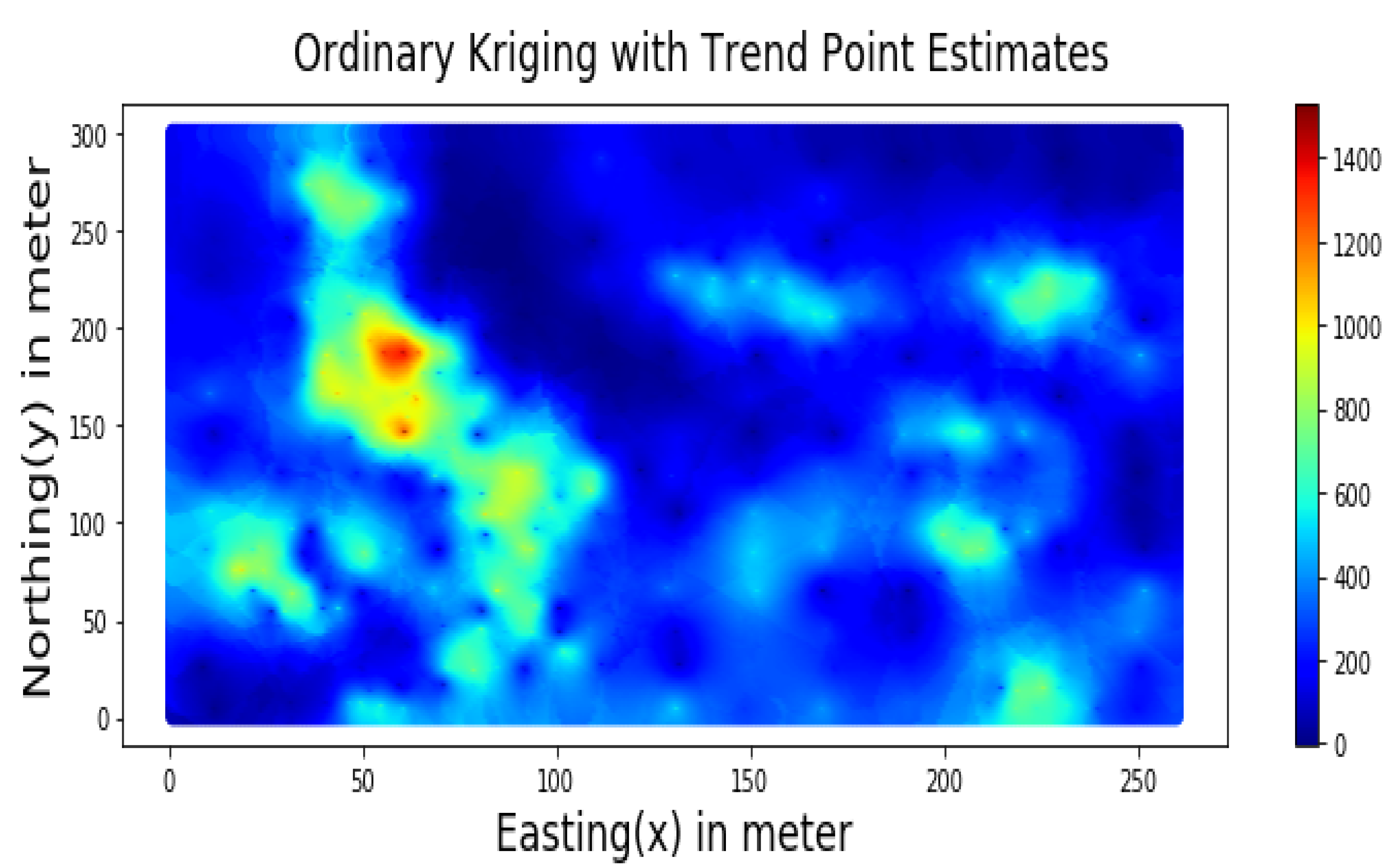
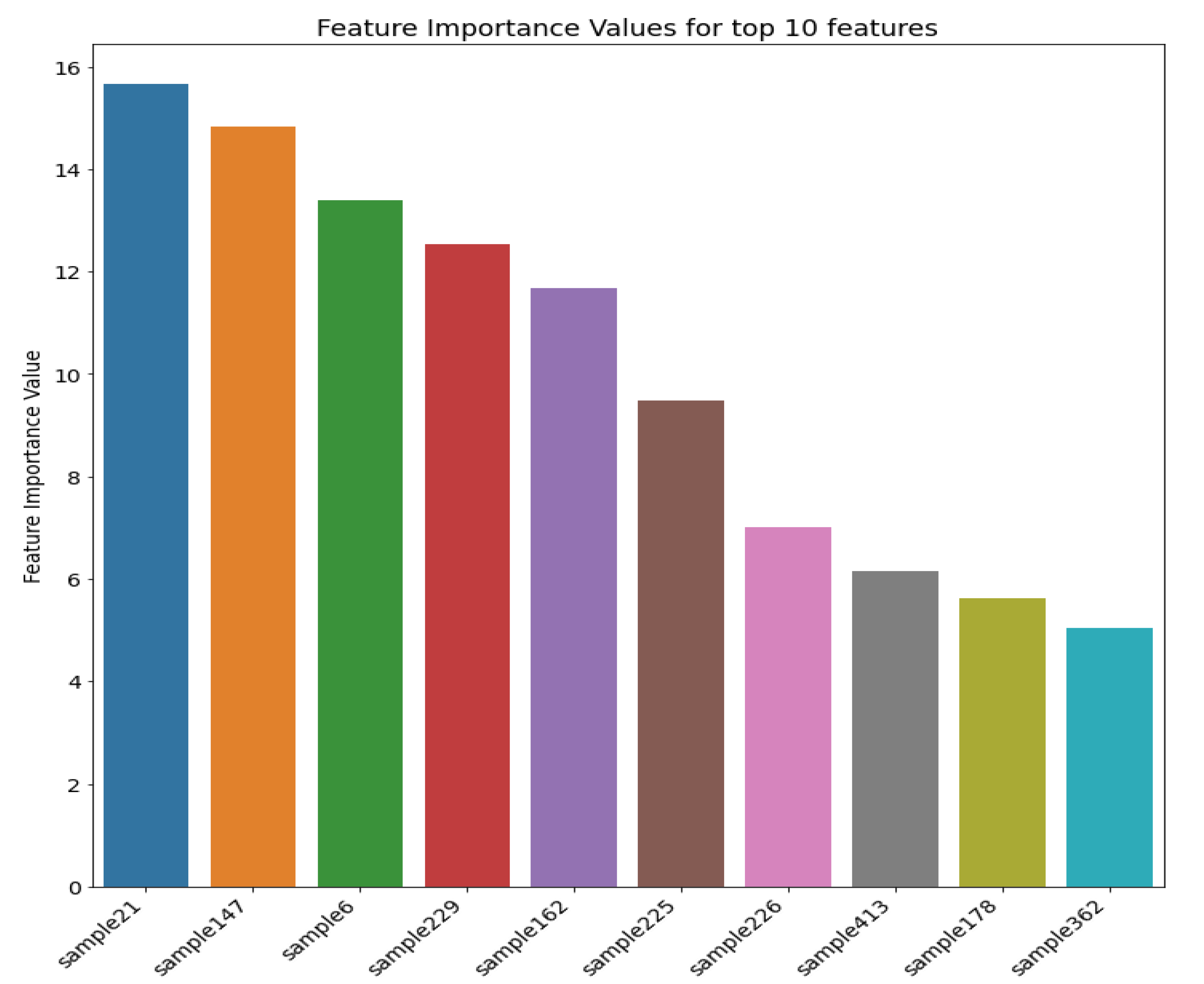
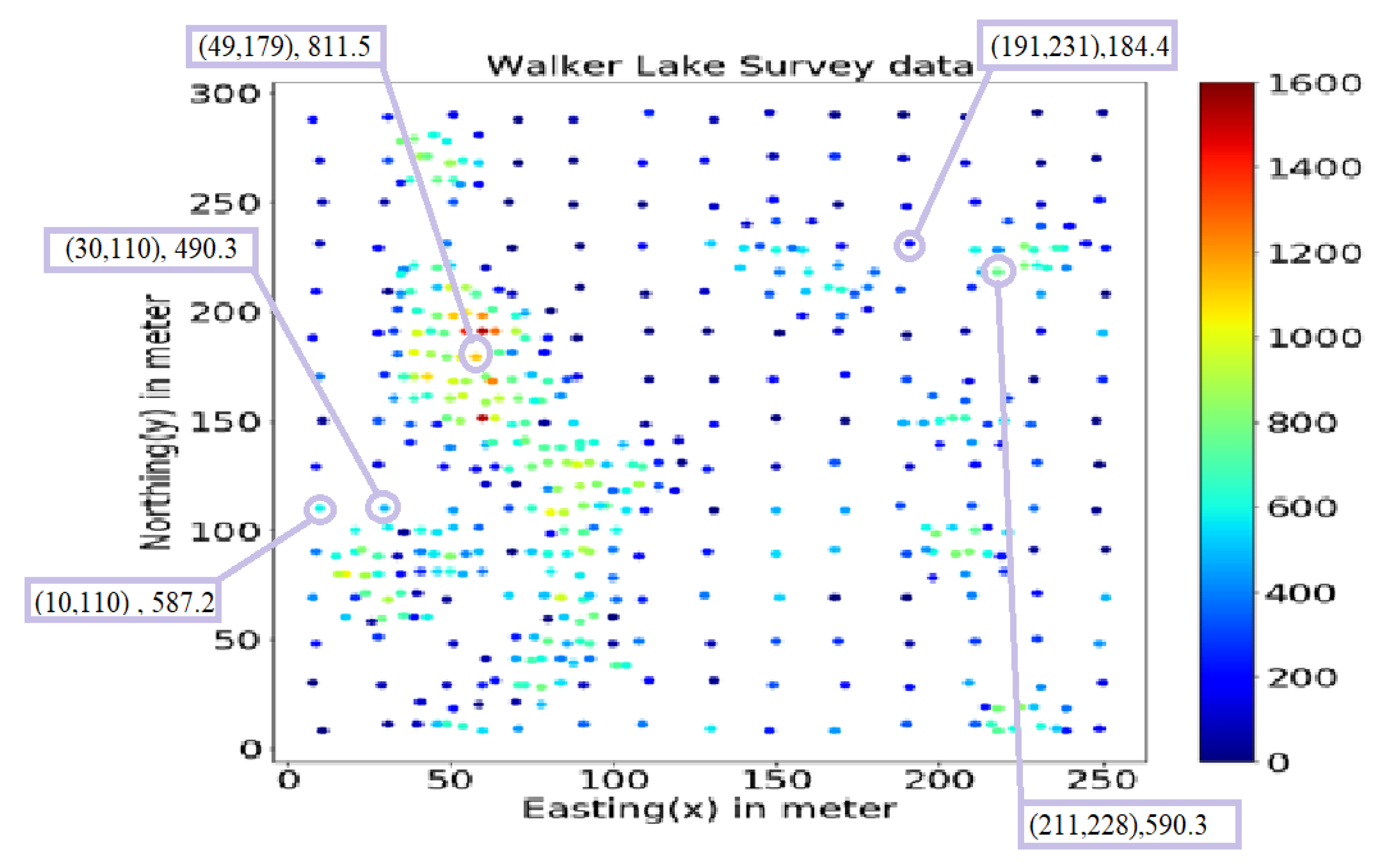
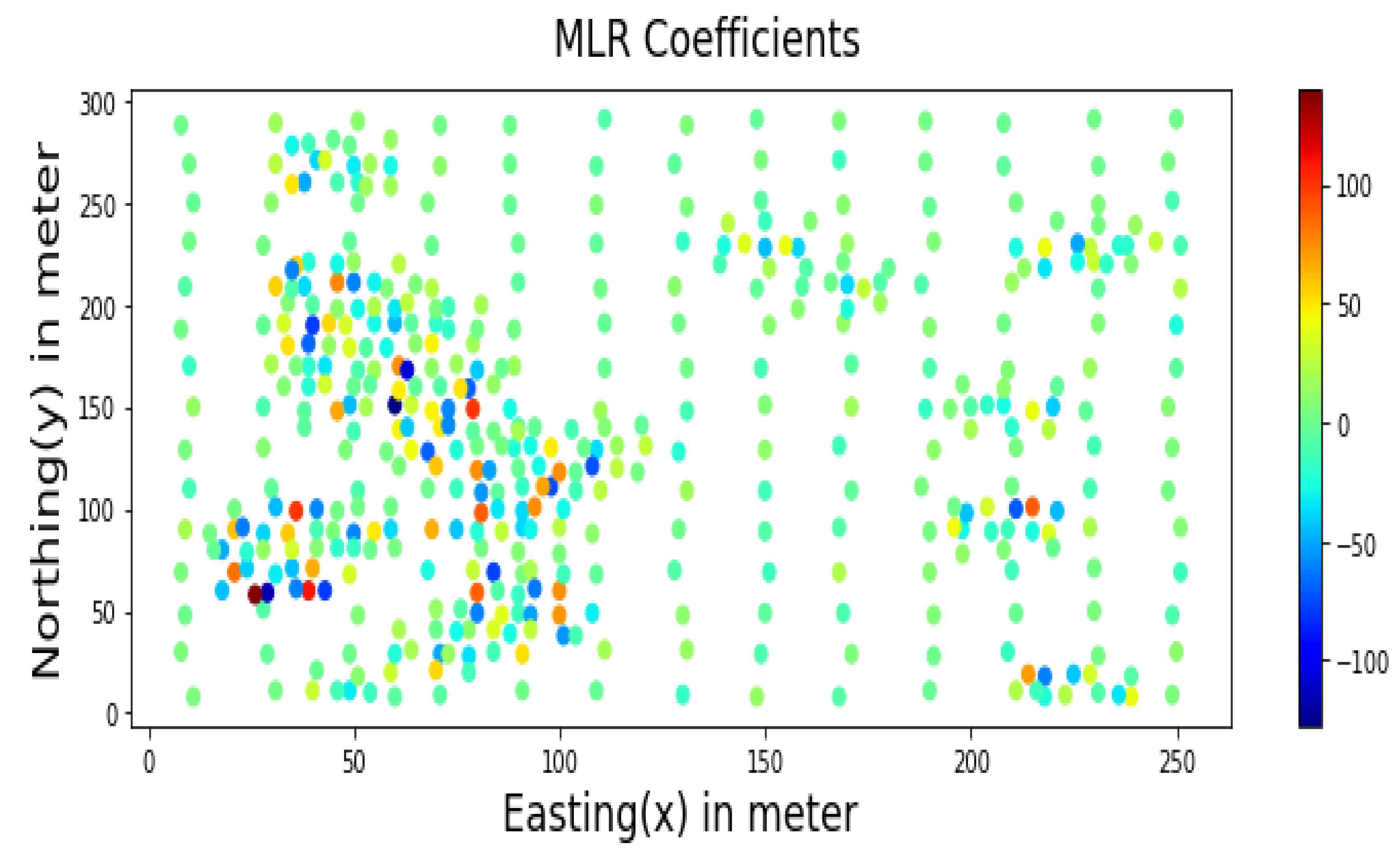
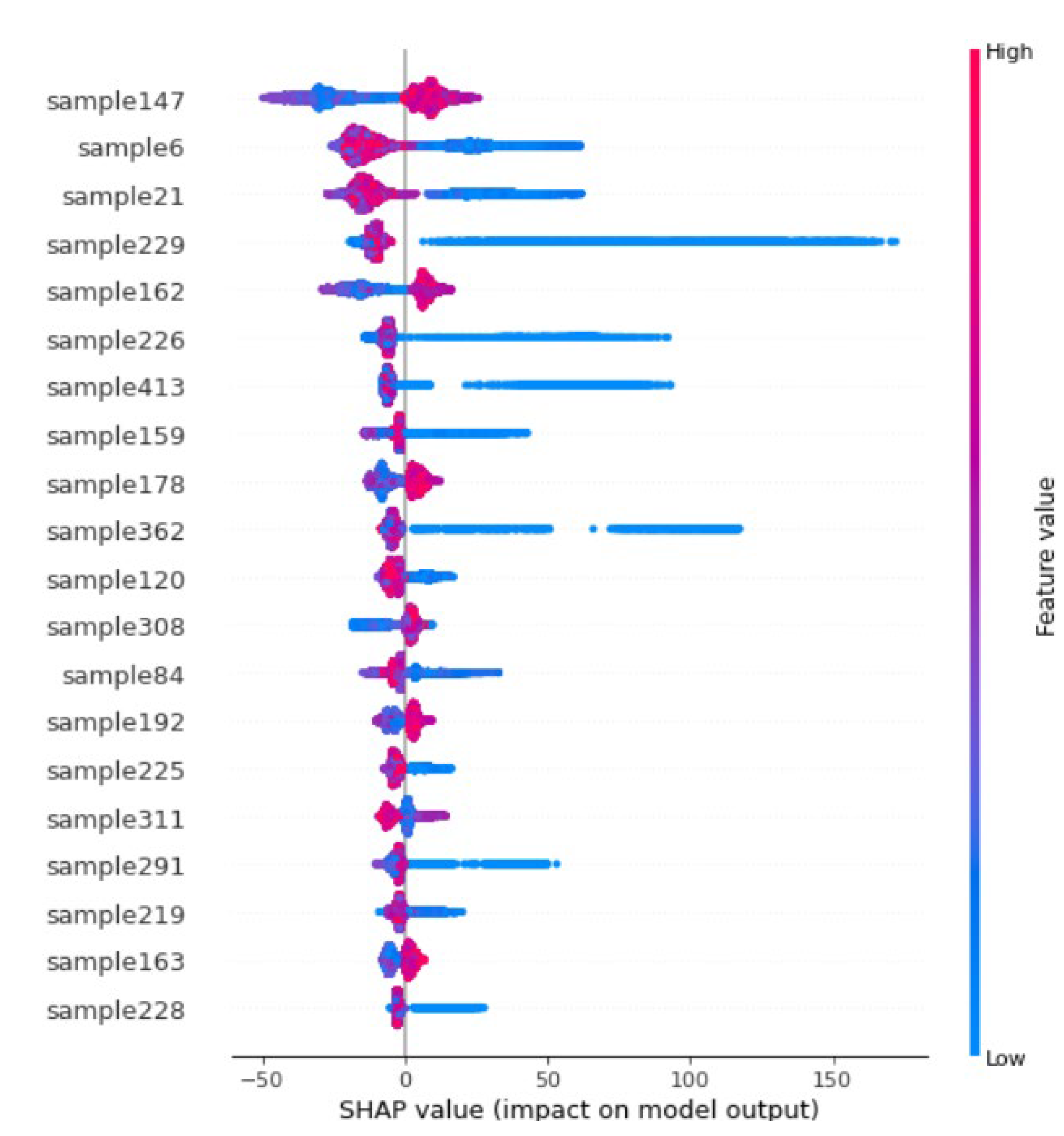
| Summary Statistics | “Survey Data” | “Exhaustive Data” |
|---|---|---|
| Data count | 470 | 78,000 |
| Mean | 435.299 | 277.979 |
| Variance | 89,929.4 | 62,423.2 |
| Maximum | 1528.1 | 1631.16 |
| Upper quartile | 639.5 | 429.34 |
| Median | 423.4 | 221.25 |
| Lower quartile | 184.4 | 67.79 |
| Minimum | 0 | 0 |
| Hyperparameters | Values |
|---|---|
| Min_samples_leaf | (0.1% to 100%) |
| Max_features | (0.1% to 100%) |
| Number of Trees | (100 to 1000) |
| Max_depth | (0.1% to 100%) |
| Min_samples_split | (0.1% to 100%) |
| Neighbors’ Distance metric | ‘Euclidean’/‘Squared Euclidean’/‘Minkowski’/‘Mahalanobis’/‘Cosine’/‘manhattan’/‘Chebyshev.’ |
| Hyperparameters | Values |
|---|---|
| Regularization | (0 to 1) |
| Neighbors’ Distance metric | ‘Euclidean’/‘Squared Euclidean’/‘Minkowski’/‘Mahlanobis’/‘Cosine’/‘manhattan’/‘Chebyshev’ |
| Hyperparameters | Value | Hyperparameters | Value |
|---|---|---|---|
| Min_samples_leaf | 0.01% | Max_depth | 100% |
| Max_features | 100% | Min_samples_split | 0.01% |
| Number of Trees | 1000 | ||
| Neighbors’ Dist. metric | ‘Euclidean’ |
| Hyperparameters | Value |
|---|---|
| Regularization | 0 |
| Neighbors’ Distance metric | ‘Euclidean’ |
| Model | R-Squared | p-Value | AME | MAE | RMSE | Skill Value |
|---|---|---|---|---|---|---|
| OK | 0.624 | 0 | 17.45 | 119.0 | 154.45 | 328.64 |
| MLR | 0.652 | 0 | 6.82 | 105.4 | 147.43 | 294.03 |
| RF | 0.625 | 0 | 11.11 | 118.0 | 152.99 | 319.39 |
| Summary Statistics | “MLR” | “RF” | “OK” | “Exhaustive Data” |
|---|---|---|---|---|
| Data count | 78,000 | 78,000 | 78,000 | 78,000 |
| Mean | 271.2 | 288.2 | 295.42 | 277.98 |
| Variance | 47,276.1 | 36,114.9 | 38,476.42 | 62,423.2 |
Publisher’s Note: MDPI stays neutral with regard to jurisdictional claims in published maps and institutional affiliations. |
© 2022 by the authors. Licensee MDPI, Basel, Switzerland. This article is an open access article distributed under the terms and conditions of the Creative Commons Attribution (CC BY) license (https://creativecommons.org/licenses/by/4.0/).
Share and Cite
Ahmed, W.; Muhammad, K.; Glass, H.J.; Chatterjee, S.; Khan, A.; Hussain, A. Novel MLR-RF-Based Geospatial Techniques: A Comparison with OK. ISPRS Int. J. Geo-Inf. 2022, 11, 371. https://doi.org/10.3390/ijgi11070371
Ahmed W, Muhammad K, Glass HJ, Chatterjee S, Khan A, Hussain A. Novel MLR-RF-Based Geospatial Techniques: A Comparison with OK. ISPRS International Journal of Geo-Information. 2022; 11(7):371. https://doi.org/10.3390/ijgi11070371
Chicago/Turabian StyleAhmed, Waqas, Khan Muhammad, Hylke Jan Glass, Snehamoy Chatterjee, Asif Khan, and Abid Hussain. 2022. "Novel MLR-RF-Based Geospatial Techniques: A Comparison with OK" ISPRS International Journal of Geo-Information 11, no. 7: 371. https://doi.org/10.3390/ijgi11070371
APA StyleAhmed, W., Muhammad, K., Glass, H. J., Chatterjee, S., Khan, A., & Hussain, A. (2022). Novel MLR-RF-Based Geospatial Techniques: A Comparison with OK. ISPRS International Journal of Geo-Information, 11(7), 371. https://doi.org/10.3390/ijgi11070371







